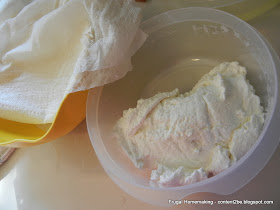Making yogurt can seem intimidating. Kinda like 'fessing up to your husband that you ate the last piece of his dark chocolate--and you better believe I know something about that!
It really is simple, and it is outrageously inexpensive compared to the little 6 oz. tubs that you buy from the store for a $1 each. Based on a $3 gallon of milk and a $1 starter, you can make at least 12 servings of Greek yogurt for no more than $.33 each! That's a savings of nearly 70%!
Homemade Greek yogurt with strawberries and raw honey
Here's what you need:
- A gallon ( or however much you want) of milk - the higher the percentage of fat, the creamier the yogurt.
- 2-3 tablespoons of plain yogurt, also referred to as the starter
110-115 degrees -- the perfect temperature for live yogurt cultures to marry and proliferate
In a nutshell:
- Heat the milk to just below a simmer.
- Let the milk cool to lukewarm.
- Add the starter and stir to combine.
- Let the milk/yogurt sit covered and undisturbed in a warm place for 8-12 hours.
- For thicker Greek yogurt, strain in a lined colander for an hour or two to separate the whey from the yogurt.
My strained Greek yogurt - I do mine in batches because my colander isn't very large.
And here are the detailed instructions:
- In a large pot, heat the milk over medium heat until the milk starts to get little foamy bubbles around the edge of the pot, just below boiling. If you use a candy thermometer, you want to reach 180 degrees. This denatures the milk, creating a better textured yogurt. If you want the whys and wherefores for doing this, check this article out.
- Allow the milk to cool to lukewarm, which is around 110-115 degrees. If the milk is too warm when you add the starter, it will kill off the live bacteria.
- Add a half cup of the warm milk to the starter, stirring to combine. Add the starter mixture to the lukewarm milk.
- Cover the pot with the lid, then place the pot wrapped in a bath towel in the oven or some other warm place. I turned my oven onto its lowest setting for about 3 minutes, then shut it off before putting the pot in. You just want the yogurt to incubate in a semi-warm place. I've read that others just leave their oven light on.
- Allow the yogurt to sit for 8-12 hours and culture. The longer you allow the yogurt to sit, the more sour it will be.
- Homemade yogurt is usually more runny but less sour than the store-bought counterpart. To make Greek yogurt, line a colander with a paper towel or a coffee filter. Pour the yogurt into the colander and allow to sit for an hour or two. I cover the yogurt with another wet paper towel and put a couple of dessert plates on top to create a little pressure and speed up the separation process. The longer it sits, the thicker the yogurt will be. In my experience, after an hour, the yogurt will be about the consistency of store bought; after 2 hours, it's like Greek yogurt.
- You can sweeten the yogurt at step #3 if you want it all to be sweet, or you can sweeten individual servings.
 |
| Leftover whey from straining |
If you're wondering what to do with all the leftover whey, here and here are an excellent collection of tips. FYI: I tried making ricotta cheese from whey, and it did NOT work for me. I did make this healthy lemonade recipe that uses whey, and my family had no idea it was made with anything out of the ordinary.
This yogurt will stay good for 7-10 days, and possibly even as long as 2 weeks.




Since I'm the only one in the family who will eat yogurt - a couple of questions: if cutting down to half a gallon, simply cut down to 1 1/2 spoons full, too? Can the starter be any plain yogurt, or should it actually be defined as a starter? Thanks so much!!
ReplyDelete@Phyllis BlickensderferAs far as the starter, you are just using regular plain yogurt that you buy in the grocery store. Nothing fancy. I am calling it the starter for this recipe since you are using it to introduce the cultures to your milk and start the yogurt-making. Also, the amount of starter that you use is pretty loose. Sometimes I just throw the whole tub of plain yogurt into the pot if I don't have an immediate use for it. You really just need enough to get the culture started, so 2-3 tsp. should be plenty with however much yogurt you want to make. Keep out a few spoonfuls to make your next batch. You can also freeze the starter in ice cube trays, and thaw when you are ready to make more!
ReplyDelete@Phyllis Blickensderfer
ReplyDeleteNo matter the amount of milk, you want to add about 2-3 tsp of yogurt. More won't hurt anything, but less than that and there won't be enough bacteria to turn the milk into yogurt. My family adds 2-3 tsp for an entire gallon of milk.
Also, we use store-bought yogurt to make our own. After that, we simply use our old yogurt to make the next pot of yogurt!
Thanks for sharing April!
Hi April!
ReplyDeleteI just found your blog after searching for homemade yogurt recipes... and not only did I find a recipe, but I found your cute little blog too! I just started my own blog recently, with much the same intentions as yourself! Thanks for sharing, and I can't wait to try making my own homemade yogurt soon!